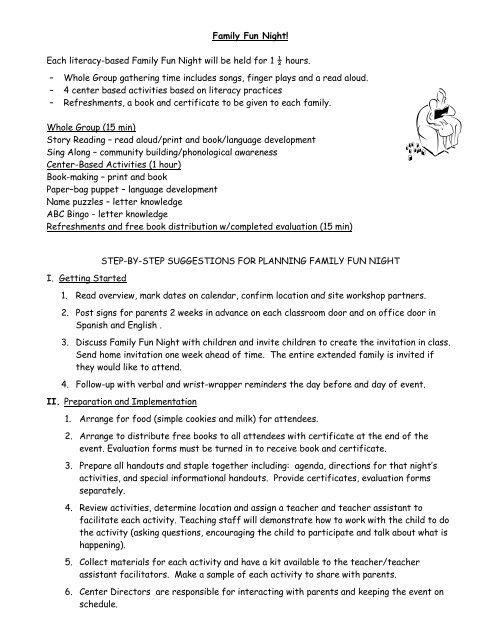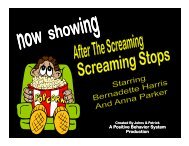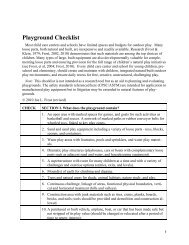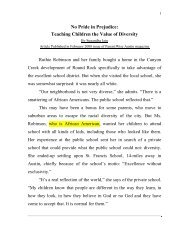Family Literacy Nights - Texas Association for the Education of ...
Family Literacy Nights - Texas Association for the Education of ...
Family Literacy Nights - Texas Association for the Education of ...
Create successful ePaper yourself
Turn your PDF publications into a flip-book with our unique Google optimized e-Paper software.
<strong>Family</strong> Fun Night!Each literacy-based <strong>Family</strong> Fun Night will be held <strong>for</strong> 1 ½ hours.– Whole Group ga<strong>the</strong>ring time includes songs, finger plays and a read aloud.– 4 center based activities based on literacy practices– Refreshments, a book and certificate to be given to each family.Whole Group (15 min)Story Reading – read aloud/print and book/language developmentSing Along – community building/phonological awarenessCenter-Based Activities (1 hour)Book-making – print and bookPaper–bag puppet – language developmentName puzzles – letter knowledgeABC Bingo - letter knowledgeRefreshments and free book distribution w/completed evaluation (15 min)I. Getting StartedSTEP-BY-STEP SUGGESTIONS FOR PLANNING FAMILY FUN NIGHT1. Read overview, mark dates on calendar, confirm location and site workshop partners.2. Post signs <strong>for</strong> parents 2 weeks in advance on each classroom door and on <strong>of</strong>fice door inSpanish and English .3. Discuss <strong>Family</strong> Fun Night with children and invite children to create <strong>the</strong> invitation in class.Send home invitation one week ahead <strong>of</strong> time. The entire extended family is invited if<strong>the</strong>y would like to attend.4. Follow-up with verbal and wrist-wrapper reminders <strong>the</strong> day be<strong>for</strong>e and day <strong>of</strong> event.II. Preparation and Implementation1. Arrange <strong>for</strong> food (simple cookies and milk) <strong>for</strong> attendees.2. Arrange to distribute free books to all attendees with certificate at <strong>the</strong> end <strong>of</strong> <strong>the</strong>event. Evaluation <strong>for</strong>ms must be turned in to receive book and certificate.3. Prepare all handouts and staple toge<strong>the</strong>r including: agenda, directions <strong>for</strong> that night’sactivities, and special in<strong>for</strong>mational handouts. Provide certificates, evaluation <strong>for</strong>msseparately.4. Review activities, determine location and assign a teacher and teacher assistant t<strong>of</strong>acilitate each activity. Teaching staff will demonstrate how to work with <strong>the</strong> child to do<strong>the</strong> activity (asking questions, encouraging <strong>the</strong> child to participate and talk about what ishappening).5. Collect materials <strong>for</strong> each activity and have a kit available to <strong>the</strong> teacher/teacherassistant facilitators. Make a sample <strong>of</strong> each activity to share with parents.6. Center Directors are responsible <strong>for</strong> interacting with parents and keeping <strong>the</strong> event onschedule.
10 Ways to Help Your Young Child Read and Write1. Use your child’s interests as a guide.Encourage your child where he/she is in his/her stage <strong>of</strong> development.(Ex: Do <strong>the</strong>y like to paint, work puzzles, play with playdoh, build with blocks? Give <strong>the</strong>m this opportunity.)Forcing a young child to write, cut with scissors, or read at too early an age produces frustration,boredom (especially as <strong>the</strong>y get older) and even failure as most young children do not have <strong>the</strong> muscledevelopment or fine motor control necessary <strong>for</strong> this skill yet.2. Read to your child daily.It is especially important to read books <strong>the</strong>y are interested in and have selected even if you’ve read <strong>the</strong>mmany times be<strong>for</strong>e. Include a wide variety <strong>of</strong> materials: books, magazines, newspaper, shopping lists, mail,signs in <strong>the</strong> environment, menus, recipes, etc.3. Let your child dictate stories to you.Write down <strong>the</strong>ir stories. They can illustrate <strong>the</strong> story by drawing a picture, too.It is very important that children see that spoken words can become printed words.4. Write your child’s name on large card or paper.Have <strong>the</strong>m trace name with glue and sprinkle with glitter or cover with yarn.(You can even use jello powder to create a smelly name card.)5. Encourage your child to act out or retell favorite stories.They especially enjoy acting out nursery rhymes, fairy tales, and stories <strong>the</strong>y have written.6. Play a board game or card game with your child.This provides a ready-made reading opportunity.Reading <strong>the</strong> directions and game components with your child helps develop skills while having fun.7. Check It Off.By making a chart <strong>of</strong> your child’s responsibilities and daily activities, you can help establish routines andread toge<strong>the</strong>r, too. Have your child read and check <strong>of</strong>f each activity as it is done.8. <strong>Family</strong> MemoriesWhen your child receives a special card or o<strong>the</strong>r momento, suggest making a memory scrapbook. Haveyour child ~read <strong>the</strong> scrapbook to you each time you add a new keepsake.A scrapbook <strong>of</strong> your child’s years at Head Start would be a great way to start!9. Pet CareIf your child is interested in a pet, suggest reading toge<strong>the</strong>r about that animal.You might also read <strong>the</strong> directions on pet care products.10.It’s More Than a DateHow <strong>of</strong>ten does your child ask what day it is or how long until his/her birthday? Establish a dailyreading habit by reading <strong>the</strong> calendar toge<strong>the</strong>r. Better yet, make a personal calendar and fill it in withfamily birthdays and o<strong>the</strong>r special events. Counting down to special occasions will help develop mathskills as well.There’s no better reason <strong>for</strong> reading toge<strong>the</strong>r than reading <strong>for</strong> fun!!Sharing a good story is a great way to end your day!!
<strong>Family</strong> Fun Night!Welcome to our Pajama Party!To celebrate a year full <strong>of</strong> learning, we thought it might be fun to explore toge<strong>the</strong>r differentways to promote literacy (reading, writing, speaking, and listening) with our children. Our eveningwill begin with a Sing-Along and Story Time followed by a variety <strong>of</strong> activities in each <strong>of</strong> <strong>the</strong>classrooms. You are free to move from classroom to classroom to participate with your children.We will end our evening toge<strong>the</strong>r with refreshments!!Sing Along/Story TimeActivity HourPuppetsBook – MakingName PuzzlesABC BingoRefreshments6:30pm - 6:45pm6:45pm - 7:45pm7:45pm - 8:00pmBe<strong>for</strong>e Leaving:‣ Please turn in your evaluation <strong>for</strong>m to receive a free book and certificate <strong>for</strong> your family.Thank you <strong>for</strong> coming and sharing your evening with us!
ABC BingoWhat you need3 Bingo Boards – printed on colored cardstock(1 <strong>of</strong>each color)1 sheet <strong>of</strong> ABC stickers13 3x5 index cards, cut in half27 Bingo circlesSheet protectors <strong>for</strong> Bingo BoardsSmall size baggie to hold alphabet letter cardsBlack SharpiesGlue sticksScissorsWhat you do1.Place 1 letter sticker in each space on <strong>the</strong> bingoboards (x,y,z in same space)leaving middle space as afree space on each board2. Write a different letter on each <strong>of</strong> 26 ½ sizeindex cards3. Place letter cards in small sized baggies (store insheet protector).4. Play ABC Bingo game during <strong>Family</strong> Fun Night.How you play1. Place 3 ABC Bingo Boards on <strong>the</strong> table.2. Place letter cards onto table, face down.3. Invite child to select one letter card.4. Ask <strong>the</strong>m to look <strong>for</strong> <strong>the</strong> matching letter on <strong>the</strong>irBingo Board, <strong>the</strong> one that looks <strong>the</strong> same.5. As <strong>the</strong> child searches <strong>for</strong> <strong>the</strong> right match, youcan ask, “Is this <strong>the</strong> same?” or Is this different?”6. If <strong>the</strong> child has a “match”, he/she covers up thatspace with a Bingo circle and identifies <strong>the</strong> letterand sound, if possible.7. When <strong>the</strong> entire card is covered, <strong>the</strong> child wins!Additional versions: Cover up 3 in a row; 4 corners;Tshape;X shape; Be creative!!Paper Bag PuppetWhat you needpaper bagconstruction papermarkers or crayonsglue or glue stickscissorsWhat you do1. Decide what kind <strong>of</strong> puppet you want to make.2. Decorate <strong>the</strong> bottom <strong>of</strong> <strong>the</strong> bag to look like aface.3. Add body parts as needed.4. Put your hand up inside <strong>the</strong> bag and have fun!!’Name PuzzlesWhat you need3x5 index cards (cut in half)blank envelopesmarkers, crayons, pens, pencilsWhat you do1. Write your name on <strong>the</strong> outside <strong>of</strong> <strong>the</strong> envelope.2. Count how many letters are in your name.3. Count <strong>the</strong> same number <strong>of</strong> index card squares asletters in your name.4. Write each letter <strong>of</strong> your name on 1 index cardsquare.(Remember to use an upper-case(capital) letter <strong>for</strong> <strong>the</strong>first letter in your name and lower-case letters <strong>for</strong><strong>the</strong> o<strong>the</strong>r letters in your name.)5. Put <strong>the</strong> letters in order to spell your name.6. Keep <strong>the</strong> letters in <strong>the</strong> envelope when you are notusing <strong>the</strong>m.7. Decorate your envelope!!O<strong>the</strong>r IdeasUse <strong>the</strong> letters in your name to try to make o<strong>the</strong>rwords.Use <strong>the</strong> letters in your name to help you think <strong>of</strong> o<strong>the</strong>rwords that start with <strong>the</strong> same letter/sound. Write<strong>the</strong>m down.Make a Name Puzzle <strong>for</strong> your last name.Make a Name Puzzle <strong>for</strong> each member <strong>of</strong> your family.Baggie BookWhat you needSmall Ziploc-style baggies Permanent markerMagazine / catalog pictures Scissors ,StaplerConstruction paper <strong>for</strong> cover Masking tapeWhat you do1. Lay baggies on top <strong>of</strong> each o<strong>the</strong>r with <strong>the</strong> openingfacing up. (to make it a name book, get a bag <strong>for</strong> eachletter in your child’s name)2. Staple <strong>the</strong> baggies toge<strong>the</strong>r across <strong>the</strong> bottom.Cover <strong>the</strong> staple line with masking tape to create abinding.3. Insert pictures or photos into baggies.4. You can write words to go with <strong>the</strong> pictures. Seal andread it!
<strong>Literacy</strong> Night Activity ChartGet each space in this grid stamped or signed as you complete each activity.Fill in <strong>the</strong> evaluation and at <strong>the</strong> end <strong>of</strong> <strong>the</strong> evening, turn in this page to receive: your freebook and certificateABC BingoPaper Bag PuppetName PuzzlesBaggie Book<strong>Literacy</strong> Night Activity EvaluationChild’s Name: ______________________Parent’s Name: _____________________Date: ___________________Teacher:_____________________Center Location:_____________________Please circle <strong>the</strong> activities you participated in:Name Puzzle Puppets Baggie Book ABC BingoWhat did you like about <strong>the</strong>se activities?What did you not like about <strong>the</strong>se activities, if anything?What would help improve <strong>the</strong>se activities? Suggest some ways.Thank you!Turn this in <strong>for</strong> a free book and certificate!
<strong>Family</strong> Fun Night! Sign-In SheetDate:________________________________Time:_________Location:________________CHILD’s NameFAMILY Member’s NameNumberAttending
ABC Bingo – For PlannersWhat you need3 Bingo Boards – printed on colored cardstock (1 <strong>of</strong> each color) 1 sheet <strong>of</strong> letter stickers13 3x5 index cards, cut in half Small-size baggies <strong>for</strong> alphabet letter cards2 Black Sharpies Sheet protectors <strong>for</strong> Bingo BoardsGlue sticks, ScissorsBingo circlesWhat you do1. Place 1 letter sticker in each space on <strong>the</strong> bingo boards (x,y,z in same space)leaving middle space as afree space on each board2. Write a different letter on each <strong>of</strong> 13 index cards, cut in half. ( 26 total)3. Place letter cards in small-size baggies (store in sheet protector).4. Play ABC Bingo game during <strong>Family</strong> Fun Night.How you play1. Place 3 ABC Bingo Boards on <strong>the</strong> table.2. Place letter cards onto table, face down.3. Invite child to select one letter card.4. Ask <strong>the</strong>m to look <strong>for</strong> <strong>the</strong> matching letter on <strong>the</strong>ir Bingo Board, <strong>the</strong> one that looks <strong>the</strong> same.5. As <strong>the</strong> child searches <strong>for</strong> <strong>the</strong> right match, you can ask, “Is this <strong>the</strong> same?” or “Is this different?”6. If <strong>the</strong> child has a “match”, he/she covers up that space with a Bingo circle and identifies <strong>the</strong> letter andsound, if possible.7. When <strong>the</strong> entire card is covered, <strong>the</strong> child wins!Additional versions: Cover up 3 in a row; 4 corners; T shape; X shape; Be creative!!Tips <strong>for</strong> Facilitating <strong>the</strong> ActivityExplain why this activity is important (see talking points with families).Give out materials in parts:Give family set <strong>of</strong> three Bingo cards and sheet <strong>of</strong> letter stickers. Explain that one letter sticker shouldbe placed in each space on bingo boards except <strong>the</strong> “free” space in <strong>the</strong> middle <strong>of</strong> each board. x, y, and z areplaced toge<strong>the</strong>r in one space.Give family <strong>the</strong> baggie <strong>for</strong> letter cards and <strong>the</strong> index cards. Have <strong>the</strong>m put <strong>the</strong>ir name on <strong>the</strong> baggie.Demonstrate how to help a child fold and <strong>the</strong>n cut <strong>the</strong> index cards in half.Instruct family members to write a different letter on each <strong>of</strong> <strong>the</strong> index cardsCoach family as <strong>the</strong>y help child with cutting and communication.Put each set <strong>of</strong> letter cards in baggie as task is completed.Have each family play bingo game.Talking Points <strong>for</strong> FamiliesBingo is a great way to learn <strong>the</strong> concept <strong>of</strong> “matching”, and “same and different.”Bingo is a great way to learn letter names and review sounds that letters make.If your child needs more experience cutting, have <strong>the</strong>m cut <strong>the</strong> grocery ads, newspapers, orfree advertising catalogs at grocery storeYour child can also streng<strong>the</strong>n his cutting hand by playing with clay or playdough, picking upsmall items like cotton balls with kitchen tongs or playing with clo<strong>the</strong>spinsBe sure and talk to your child during Bingo play and ask questions. Invite your child to show you how toplay. Make silly mistakes and let your child correct you.Be sure you show your child how to neatly put up game so all <strong>the</strong> parts will be available <strong>for</strong> <strong>the</strong> next time.
Name Puzzles – <strong>for</strong> PlannersWhat you need3x5 index cards (cut in half)blank envelopesmarkers, crayons, pens, pencilsWhat you do1. Write your name on <strong>the</strong> outside <strong>of</strong> <strong>the</strong> envelope.2. Count how many letters are in your name.3. Count <strong>the</strong> same number <strong>of</strong> index card squares as letters in your name.4. Write each letter <strong>of</strong> your name on 1 index card square.(Remember to use an upper-case(capital) letter <strong>for</strong> <strong>the</strong> first letter in your name and lowercaseletters <strong>for</strong> <strong>the</strong> o<strong>the</strong>r letters in your name.)5. Put <strong>the</strong> letters in order to spell your name.6. Keep <strong>the</strong> letters in <strong>the</strong> envelope when you are not using <strong>the</strong>m.7. Now, you can decorate your envelope!!O<strong>the</strong>r IdeasUse <strong>the</strong> letters in your name to try to make o<strong>the</strong>r words.Use <strong>the</strong> letters in your name to help you think <strong>of</strong> o<strong>the</strong>r words that start with <strong>the</strong> sameletter/sound. Write <strong>the</strong>m down.Make a Name Puzzle <strong>for</strong> your last name.Make a Name Puzzle <strong>for</strong> each member <strong>of</strong> your family!Tips <strong>for</strong> facilitating <strong>the</strong> activityAsk children to tell you <strong>the</strong> letters in <strong>the</strong>ir name if <strong>the</strong>y can.Demonstrate <strong>for</strong> parents how to say each letter as <strong>the</strong>y are writing it.You can also have children count how many letters are in <strong>the</strong>ir name so <strong>the</strong>y will know how manyindex card squares to get. Help <strong>the</strong>m to make <strong>the</strong> one-to-one connection between letters in <strong>the</strong>irname and index card squares.You can scramble <strong>the</strong> letters up and have <strong>the</strong> children unscramble to make <strong>the</strong>ir name.You can also talk about <strong>the</strong> sound each letter makes in <strong>the</strong> child’s name.Talking Points <strong>for</strong> ParentsThere are many ways to support children in learning <strong>the</strong> letters in <strong>the</strong>ir names. The mostimportant thing to remember is that it needs to be meaningful to <strong>the</strong> child.You can use <strong>the</strong> child’s name as a starting point <strong>for</strong> rhyming activities and alliteration, too.The capital letter is a hint about which letter comes first when putting <strong>the</strong> name puzzle toge<strong>the</strong>r.There are also many ways to support <strong>the</strong> construction <strong>of</strong> one-to-one correspondence in day to daylife…Like counting out plates, napkins, cups, etc. at home
Paper Bag Puppet - <strong>for</strong> PlannersWhat you needpaper bagconstruction papermarkers or crayonsglue or gluestickscissorsimagination!What you do1. Decide what kind <strong>of</strong> puppet you want to make.2. Decorate <strong>the</strong> bottom <strong>of</strong> <strong>the</strong> bag to look like a face.3. Add body parts as needed.4. Put your hand up inside <strong>the</strong> bag and have fun!!’Tips <strong>for</strong> Facilitating <strong>the</strong> ActivityDemonstrate how to place <strong>the</strong> paper bag so that <strong>the</strong> face will be right side up.( Open end <strong>of</strong> paperbag closest to you.)Talk with children about <strong>the</strong> different body parts that belong on <strong>the</strong> face…eyes, ears, nose,mouth,You can talk about how many you need <strong>of</strong> each.You can also talk about <strong>the</strong> 5 senses and how we use each one <strong>of</strong> our body parts .Talking Points <strong>for</strong> ParentsLet parents know what <strong>the</strong> value is in playing with puppets. They can be used to extend orallanguage. They can also be used to encourage story retells with children.Children can be encouraged to put on “puppet shows” <strong>for</strong> family members.
Baggie Book – <strong>for</strong> PlannersWhat you needSmall Ziploc-style baggiesPermanent markerMagazine / catalog pictures ScissorsMasking tape Stapler Construction paper <strong>for</strong> coverWhat you do1. Lay baggies on top <strong>of</strong> each o<strong>the</strong>r with <strong>the</strong> opening facing up.(to make it a name book, get a bag <strong>for</strong> each letter in your child’s name)2. Staple <strong>the</strong> baggies toge<strong>the</strong>r across <strong>the</strong> bottom.(write <strong>the</strong> child’s name on a piece <strong>of</strong> construction paper <strong>for</strong> <strong>the</strong> cover and staple with <strong>the</strong>baggies)3. Cover <strong>the</strong> staple line with masking tape to create a binding.4. Insert pictures or photos into baggies.5. You can write words to go with <strong>the</strong> pictures.Tips in Facilitating <strong>the</strong> Activity:Demonstrate how to do <strong>the</strong> activity with family be<strong>for</strong>e giving <strong>the</strong>m <strong>the</strong> materials.Explain <strong>the</strong> purpose <strong>of</strong> <strong>the</strong> activity – to create a book using <strong>the</strong> letters in <strong>the</strong> child’s first name.Ask parents to help child to find pictures <strong>of</strong> things that begin with each letter in child’s name.Have conversation with <strong>the</strong> child about <strong>the</strong> picture.Explain to child, “Now we are going to write <strong>the</strong> name <strong>of</strong> <strong>the</strong> picture and <strong>the</strong>n we are going toglue <strong>the</strong> picture after <strong>the</strong> word.As you write <strong>the</strong> word, say <strong>the</strong> letters out loud ( c-o-w).Be sure and use lower case letters and explain to parents that we only use upper case letters <strong>for</strong>proper nouns (first letter in child’s name).Talking Points with Families:Each child’s name is very important to <strong>the</strong>m. Practice writing and saying each letter. Encourageyour child to practice but do not be too rigid. It needs to be fun and not perfect. They are justlearning!In order to help your child become a reader, he/she needs to know that print has meaning. Theword means <strong>the</strong> same thing as <strong>the</strong> picture.Each word is made up <strong>of</strong> letters. It is important to say each letter as you write it.It is important to use upper and lower case print correctly. Young children need to see wordswritten correctly and hear you tell <strong>the</strong>m, “we start your name with an uppercase or capital and weuse lower-case letters <strong>for</strong> <strong>the</strong> rest <strong>of</strong> your name. “ We use lower case letters <strong>for</strong> most words.Be sure and make new books and invite your child to read <strong>the</strong>m to you over and over and to copy<strong>the</strong> words if <strong>the</strong>y are interested.Make it fun. The joy <strong>of</strong> learning is what is important to young children, not perfection.
Materials ListBooks and certificates <strong>for</strong> familiesHandoutsRegistration area: Sign in Sheets / Pens and pencilsBaggie Booksziploc-type baggies (HEB brand sandwich bags @ .99 <strong>for</strong> 50) 12 boxes 600 bagsmasking tape (color, if possible)construction paper <strong>for</strong> covers – any color – about 50 sheets - can precut to size <strong>of</strong> baggiespicturesmagazinesmarkers (some permanent <strong>for</strong> writing on baggies) and crayonsstapler / extra staplesscissorsPaper Bag Puppetpaper bagconstruction papermarkers or crayonsglue or glue stickscissorsName Puzzles3x5 index cards (cut in half)Blank envelopesMarkers, crayons, pens, pencilsABC Bingo3 Bingo Boards - one <strong>of</strong> each color13 3x5 index cards – cut in half to make letter cardssheet protectors <strong>for</strong> Bingo Boards1 sheet <strong>of</strong> Letter stickers per gameSmall size baggies <strong>for</strong> alphabet letter cardsBlack SharpiesGlue sticksScissors
For participation in<strong>Family</strong> Fun NightThe ________________ familyIs declared aReading Toge<strong>the</strong>r <strong>Family</strong>CongratulationsFromFor making Reading Toge<strong>the</strong>rpart <strong>of</strong> your family traditions!!_____________Center Director_______________Date
Welcome Families!!Plan to attend our <strong>Family</strong> Fun Night !When :Where :We are beginning a year <strong>of</strong> learning toge<strong>the</strong>r !Come and join us as we sing, read, writeand make things toge<strong>the</strong>r.Your family will have <strong>the</strong> chance to...‣ make books‣ make games‣ make puppetsEach family will also receive a free children’s book!Refreshments served at <strong>the</strong> end.
Getting to Know YouPlease fill this out and turn in. Thanks!!Parent’s Name __________________.Contact Info: Email_______________Phone__________________Child’s Name _________________________.1. My goals <strong>for</strong> my child in Head Start this year are…2. My child’s strengths are…(He/She is really good at…)3. It might help you to know that my child…4. I have an interesting hobby or occupation that I would like to sharewith <strong>the</strong> class. It is…
Sample Parent CalendarSU ND AY MONDAY TUESDAY WEDNE SD AY THURSDAY FRI DAY S ATURDAYThere are many timesduring <strong>the</strong> day that you canplay with your child. As youplay and talk with yourchild you are teaching.Remember, you are yourchild’s first teacher. Hereare some ways to interactwith your child in dailyactivities.Playing in water2 It’s Dr. Seuss’birthday! ReadGreen Eggs andHamLearning is not attained by chance; it must be sought <strong>for</strong> with ardor and attended towith diligence. – Abigail Adams3 Let your childplay in <strong>the</strong> waterat <strong>the</strong> sink.Practice filling &pouring intocontainers.4 Let your childplay in <strong>the</strong> sinkwith soapywater. Ask <strong>the</strong>mhow it feels?5 Add items to<strong>the</strong> sink <strong>of</strong> waterto see what floatsand what willsink.6 Add sponges to<strong>the</strong> sink <strong>of</strong> waterand help childsqueeze <strong>the</strong>sponge to fill aplastic cup.7 Add aneggbeater to <strong>the</strong>sink <strong>of</strong> waterwith little bit <strong>of</strong>shampoo.1 Go <strong>for</strong> a walkto look at treeslook<strong>for</strong> buddingtrees.8 Go <strong>for</strong> a walkand look <strong>for</strong>shapes like:circles, squares,rectangles,trianglesRiding in a carTaking a walkHousehold chores9 Exercisetoge<strong>the</strong>r!10 While ridingin a car, name hotthings and coldthings.11 While ridingin a car, name bigthings and littlethings.12 While ridingin a car, look <strong>for</strong>signs. How manycan your childrecognize?13 While ridingin a car, singsongs toge<strong>the</strong>r.14 While ridingin a car, saynursery rhymestoge<strong>the</strong>r.15 Go <strong>for</strong> a walkand talk about all<strong>the</strong> colors youcan find.CookingCelebrating <strong>the</strong> seasonTell your child daily howmuch you love <strong>the</strong>m!16 Look in <strong>the</strong>mirror and makefaces toge<strong>the</strong>rhappy,sad,scared, hungry,mad17 Make apeanut buttersandwichtoge<strong>the</strong>r. Askyour child whatyou need to make<strong>the</strong> sandwich.18 Put shavingcream on acookie sheet. Letyour child fingerpaintin it.Practice writinghis name!19 Withplaydough, maketiny eggs and abasket. Count <strong>the</strong>eggs.20 Make letters<strong>of</strong> your child’sname out <strong>of</strong> playdough. Count<strong>the</strong> letters.21 Dye eggs <strong>for</strong>Easter. Counthow many eggsyou dyed.22 Go <strong>for</strong> a walkand look <strong>for</strong> signs<strong>of</strong> Spring. Talkabout warmingwea<strong>the</strong>r.23 Have anEaster egg hunt.30 Read a booktoge<strong>the</strong>r.24 Let yourchild help washdishes.31 Think <strong>of</strong>rhyming wordstoge<strong>the</strong>r.25 Let yourchild help set <strong>the</strong>table.26 Let yourchild help dust<strong>the</strong> furniture.27 Let yourchild help foldclo<strong>the</strong>s and put<strong>the</strong>m away.28 Make a game<strong>of</strong> picking uptoys. Sing aclean- up song.29 Go <strong>for</strong> a walkand look <strong>for</strong>letters andnumbers. Talkabout <strong>the</strong>difference inletters &numbers.
Parent FeedbackPlease answer <strong>the</strong> following questions as specifically as possibleA. List 5 things you wanted your child to learn this year in preschool.1.2.3.4.5.B. List 5 things your child learned in preschool this year.1.2.3.4.5.C. List 5 ways we can improve <strong>the</strong> quality <strong>of</strong> our preschool.1.2.3.4.5.
Parent Survey1. Do you think a home-school connection is important? Why? Why not?2. What makes it hard <strong>for</strong> parents to:a) Attend parent – teacher conferences?b) Volunteer during <strong>the</strong> day ?c) Attend evening activities ?3. What would make it easier <strong>for</strong> you to :a) Attend parent – teacher conferences?b) Volunteer during <strong>the</strong> day ?c) Attend evening activities ?4. Which activities would you be most interested in? Please circle.Evening programs: With Children Without Children Both5. What topics are you interested in learning more about at a parent program?





